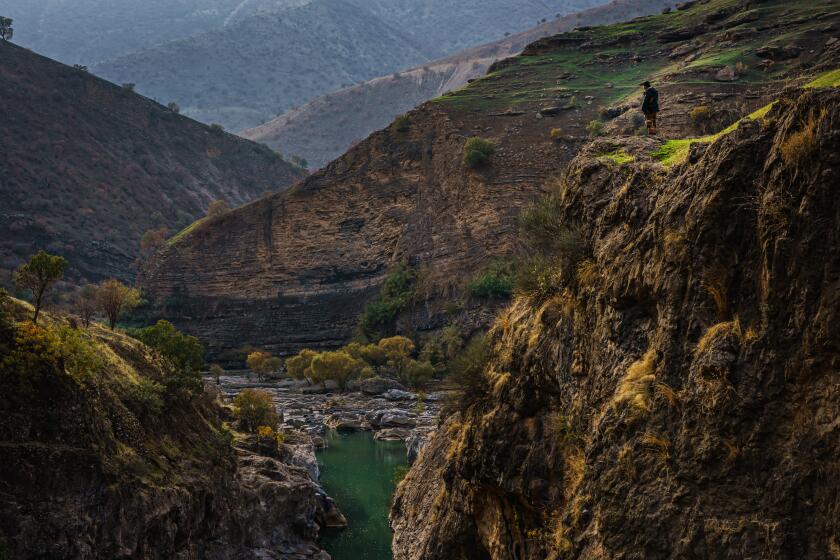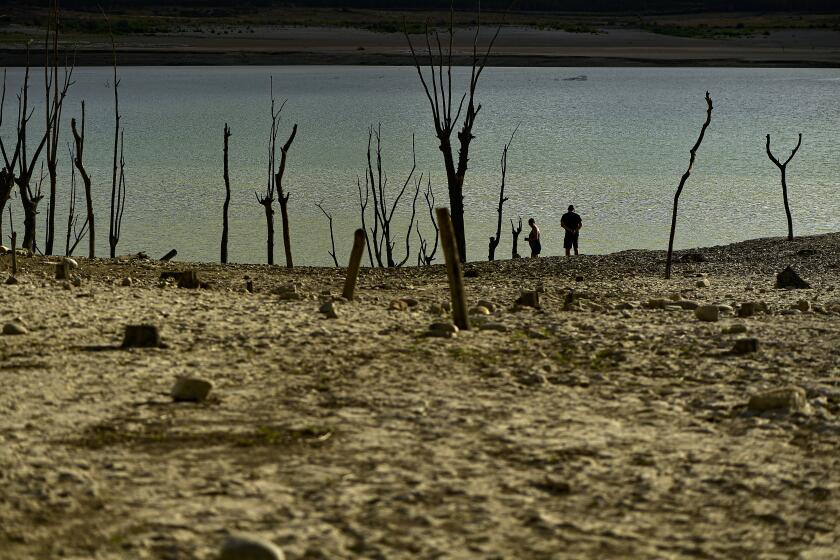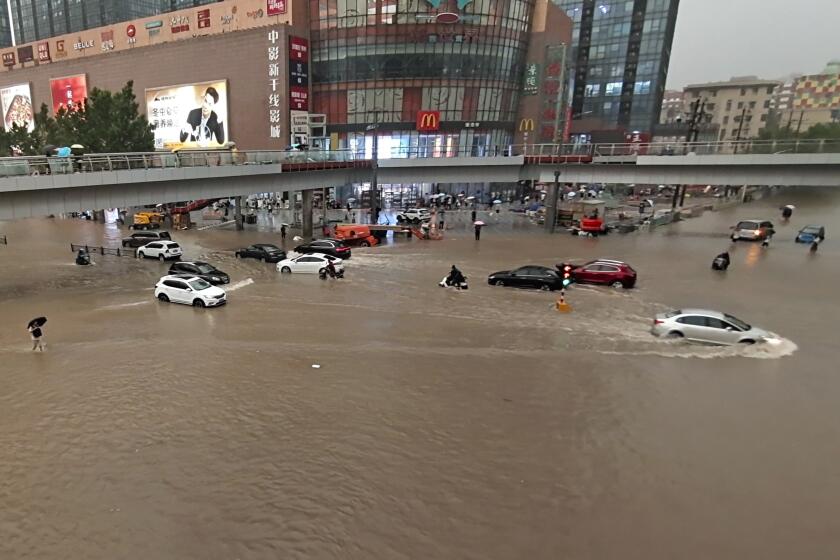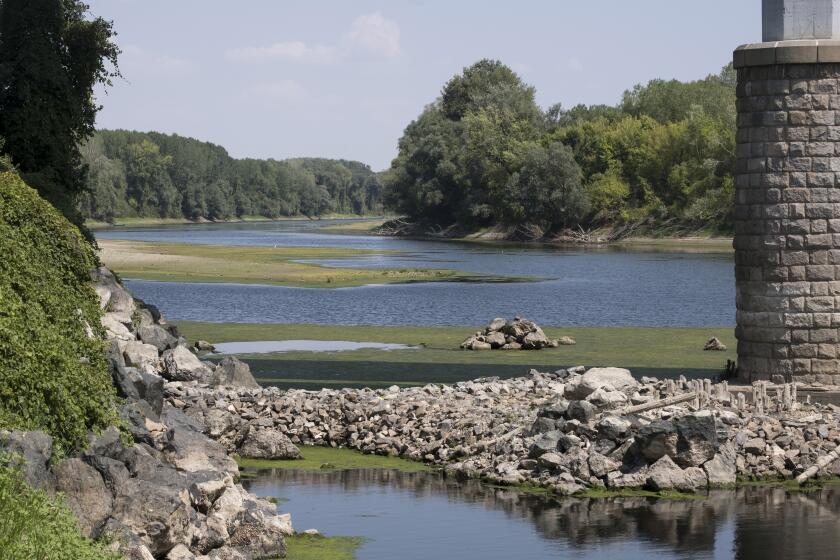Politics and climate conspire as Tigris and Euphrates dwindle
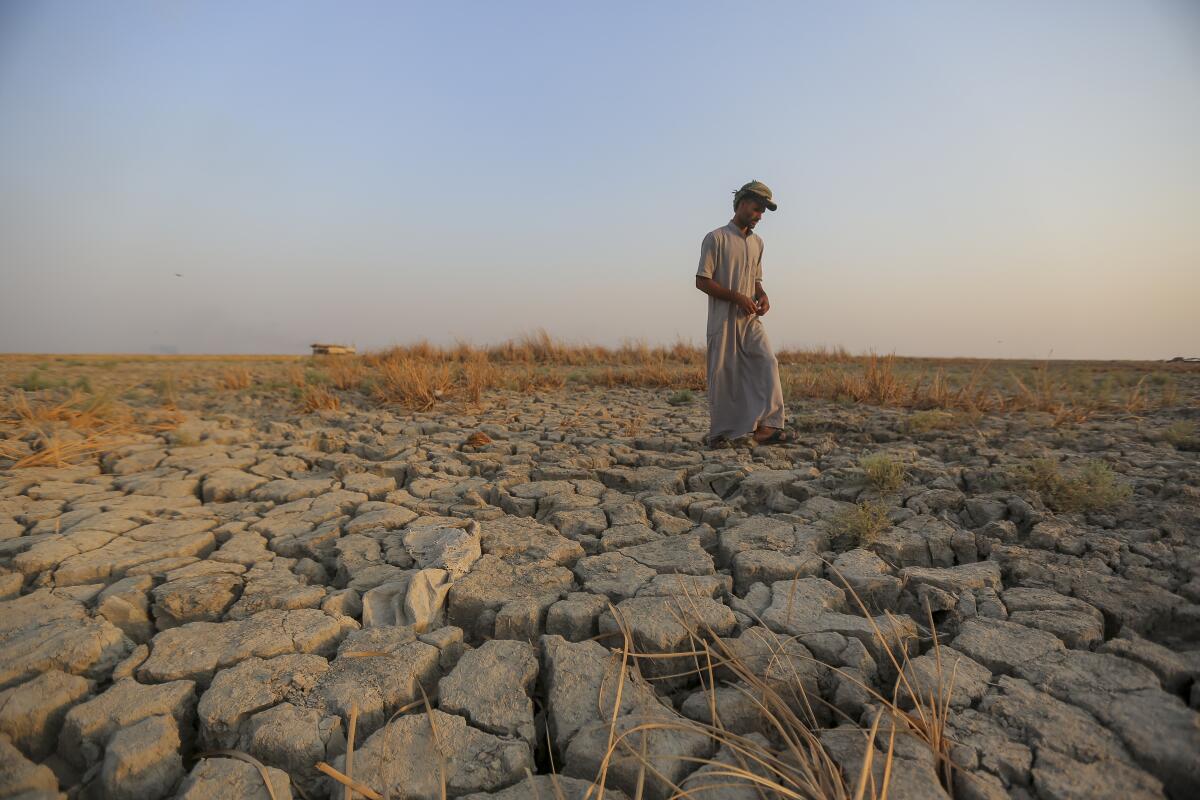
- Share via
DAWWAYAH, Iraq and ILISU DAM, Turkey — Next year, the water will come. The pipes have been laid at Ata Yigit’s sprawling farm in Turkey’s southeast connecting it to a dam on the Euphrates River. A dream, soon to become a reality, he says.
He’s already grown a small corn patch on some of the water. The golden stalks are tall and abundant. “The kernels are big,” he says, proudly. Soon he’ll be able to water all his fields.
More than 625 miles downstream in southern Iraq, nothing grows anymore on Obeid Hafez’s wheat farm. The water stopped coming a year ago, the 95-year-old said, straining to speak.
“The last time we planted the seed, it went green, then suddenly it died,” he said.
The starkly different realities are playing out along the length of the Tigris-Euphrates river basin, one of the world’s most vulnerable watersheds. River flows have fallen by 40% in the last four decades as the states along its length — Turkey, Syria, Iran and Iraq — pursue rapid, unilateral development of the water’s use.
The drop is projected to worsen as temperatures rise from climate change. Both Turkey and Iraq, the two biggest consumers, acknowledge they must cooperate to preserve the river system that some 60 million people rely on to sustain their lives.
But political failures and intransigence conspire to prevent a deal sharing the rivers.
Ancient humans are believed to have first begun land cultivation in Iraq. Their modern-day counterparts are giving it up.
The Associated Press conducted more than a dozen interviews in both countries, from top water envoys and senior officials to local farmers, and gained exclusive visits to controversial dam projects. Internal reports and revealed data illustrate the calculations driving disputes behind closed doors, from Iraq’s fears of a potential 20% drop in food production to Turkey’s struggles to balance Iraq’s and its own needs.
“I don’t see a solution,” said former Iraqi Prime Minister Haider Abadi.
“Would Turkey sacrifice its own interests? Especially if that means that by giving more [water] to us, their farmers and people will suffer?”
A farmer’s dream
Turkey has been harnessing the river basin with a massive project to boost agriculture and generate hydroelectricity. Under its Southeast Anatolia Project, or GAP by its Turkish acronym, it has built at least 19 dams on the Euphrates and Tigris, and several more are envisaged for a total of 22.
It aims to develop the southeast, long an economic backwater and the wellspring of the Kurdistan Worker’s Party, or PKK, a Kurdish separatist movement that Turkey considers a terrorist organization.
For Yigit, the project will be transformative.
Until now, his reliance on well water only permitted half his land to be irrigated.
But in June, the irrigation pipes finally reached his farm in Mardin province. Next year, his entire 4,500 acres will be watered via the Ataturk Dam on the Euphrates River.
Severe water shortages in Europe, the U.S. and China over the summer were made 20 times more likely by climate change, according to a new study.
Lower water availability forced a revision in the area that GAP will irrigate, down to 1.05 million hectares, from an original 1.8 million. Half the reduced goal has been met. The rest depends on how quickly authorities can install infrastructure linking villages to the dams.
Farmers benefitting from GAP must use advanced irrigation techniques that Turkish authorities say use two-thirds less water.
But for an anxious Iraq, every drop of water diverted for irrigation means less downstream.
Still, in Yigit’s world, the future is finally bright.
“Next year, the canals will be open.”
Climate change is making the world more prone to floods like those in China and Europe and to heat waves and fires like those in the U.S. and Russia.
‘A single truth’
Iraq is the downstream prisoner of geography, relying almost entirely for its water on the twin rivers and tributaries originating outside its borders.
In 2014, Iraq’s Water Ministry prepared a confidential report that spelled out a “single truth”: In two years, Iraq’s water supply would no longer meet demand, and the gap would keep widening. The report, seen by the AP, warned that by 2035, the water deficit would cause a 20% reduction in food production.
The doomsday predictions are playing out in 2022. Lakes have dried up, crops have failed, and thousands of Iraqis are migrating. An author of the report, who spoke anonymously because it is not public, said the predictions were “remarkably accurate.”
They show Iraqi officials knew how bleak the future would be without the recommended $180 billion in investment and an agreement with neighbors. Neither transpired.
Decades of talks have still not found common ground on water-sharing.
Turkey approaches the water issue as if it were the river basin’s benevolent owner, assessing needs and deciding how much to let flow downstream. Iraq considers ownership shared and wants a more permanent arrangement with defined portions.
Europe is facing one of its worst droughts ever, as rivers dry up, farms go fallow and vineyards roast.
In a rare interview, Turkey’s envoy on water issues with Iraq, Veysel Eroglu, told the AP that Turkey cannot accept to release a fixed amount of water because of the unpredictability of river flows in the age of climate change.
Eroglu said Turkey could agree to setting a ratio to release — but only if Syria and Iraq provide detailed data on their water consumption.
“That is the only way to share water in an optimal and fair manner,” he said.
The question of Syria is a major obstacle. Turkey insists it must be part of any broad agreement but that for the time being it has no interlocutor in that war-torn neighbor.
Both sides treat some data like state secrets, fueling mistrust.
“I like to keep it to myself,” Eroglu’s Iraqi counterpart, Mahdi Hamdani, said regarding his country’s water consumption data. “They are tools in our negotiations.”
Hamdani stepped down from his position after a new government was voted into power in October, underscoring another gripe from Turkey: The frequent changing of Iraqi interlocutors in the water talks.
One Iraqi ambassador said it was “a mistake” that his side once informed the Turks that they were aware that 70% of their water is effectively wasted on ancient farming practices then discharged to the Persian Gulf, leading Ankara to reiterate demands that Iraq reform itself first.
Turkey is relatively forthcoming with Tigris data but reveals little about the Euphrates, particularly the vital question of how much water will be diverted to irrigation under GAP. It says only that diversion will be minimal.
It also argues that, if it’s shared water, Iraq must be more responsible with it and introduce greater efficiency, like Turkey.
Iraq bristles at being told how to use its water.
“Sometimes they ask us why Iraq cultivates [water-intensive] rice,” Hamdani said. “I ask them, why are you cultivating cotton? And they say it’s part of their history, civilization. And I tell them yes, we also have our history, our civilization.
“If we keep talking like this, we will never reach an agreement.”
‘Your eyes, your scale’
Sheikh Thamer Saeedi decided enough is enough. The streams were dry in his village in southern Iraq. Despairing families were abandoning their farms for the city after crops failed.
What he did next underscores rising anger among farmers following devastating, back-to-back droughts — and the Iraqi government’s weaknesses that make managing water nearly impossible.
“One week,” Saeedi told local water authorities in Dhi Qar province. Release more water to his district, Dawwayah, he threatened, or else he would take matters into his own hands.
In Iraq’s south, tribal allegiance transcends government authority. As a tribal leader, Saeedi had to guarantee water for his people to safeguard his legitimacy.
The authorities were in a bind. Water levels in the Gharraf River, the Tigris’ branch here, were so low the water didn’t reach the diversion gates, designed in the 1970s when flows were twice as high. Districts like Dawwayah, farther along the irrigation network, were left dry.
At the same time, the government had cut the province’s water allocation by 60%.
Time ran out.
Saeedi marched with dozens of followers to the irrigation regulator on the riverbank, armed with a long pipe and shovels. They dug until a water corridor was secured to his district.
“My people are thirsty,” he said.
To ensure he left enough water for other communities, Saeedi invoked the Arabic idiom: “Your eyes, your scale.” That is, he took a wild guess.
Rival tribal leaders were enraged, fearing for their own water supplies. Security officials rushed to put a halt to the diversion. Many feared gun battles if they hadn’t.
“It was a destructive act,” said Ghazwan Kadhim, head of Dhi Qar’s Water Resources Directorate. “The Gharraf River has 154 gates to different areas. If anyone does anything like that, the entire river would become unfit for distributing water.”
But authorities are having a harder time keeping a lid on fights over water. Threats of lawsuits do little to stop tribal leaders diverting flows or digging illegal wells; using security forces risks escalation.
“We are terrified of conflict breaking out in central and southern Iraq over the water shortages,” said Issa Fayadh, an official at the Environment Ministry in Baghdad.
A numbers game
Straddling between ridges in southeast Turkey, the Ilisu Dam is — for Iraqis — a stark reminder of an irretrievable past.
Before Turkey began operating the dam in May 2020, all the waters of the Tigris River flowed into Iraq. Now how much water comes down depends on Ankara’s consideration of Iraq’s month-to-month requests for a minimum flow, weighed against Turkey’s own needs.
The AP was given an exclusive tour of the dam facility in October by Turkey’s State Hydraulics Works, known by the Turkish acronym DSI, and given figures for the first time detailing flow rates and electricity production over two years.
A decade ago, Iraq received an average flow of 625 cubic meters of water per second from the Tigris. Today, the rate averages 36% of that because of less precipitation combined with the dam’s effect, Iraqi water ministry officials say.
The dam is used for hydroelectricity, not irrigation, so eventually water must be let through for the turbines.
But how much and when are another matter. Turkish officials must maintain a minimum reservoir level of 500 meters above sea level to produce electricity, even as they face a lower, less predictable flow into the reservoir.
In 2021, Ilisu discharged 20% more water than it received and had to draw on water stored from previous years, according to figures from Eroglu.
In January, the reservoir’s level dropped below the 500-meter mark. Power production this year fell 20% compared with 2021. Ilisu on average produces less than half its potential.
Turkish officials argue that with the dam, they can regulate flow for Iraq’s benefit, storing more during floods and discharging more during drought.
Data provided by DSI shows that Turkey respected a request made by Iraq that it release at least 300 cubic meters per second down the Tigris during summer months, when shortages are common.
But Iraqi officials say depending on such ad hoc arrangements makes planning difficult.
“They can cut water, they can release water. We urgently need a water agreement just to satisfy Iraq’s minimum requirements,” said Hatem Hamid, head of the National Center for Water Resources Management.
Once the Tigris waters reach Mosul Dam, Hamid decides how much goes where in Iraq. The consequences of his calculations can be monumental.
With dire shortages anticipated in 2022, Hamid had to make severe cuts, slicing water quotas in half for agriculture. Water rationing was enforced with military patrols.
That also reduced the Tigris’ water entering the marshlands of southern Iraq. What Hamid could not have predicted was that water-stressed Iran then diverted tributaries feeding the marshes.
The result was an environmental emergency: Not enough fresh water was entering the marshes to wash away salinity.
Hamid scrambled to divert more water, but the damage was done.
‘Life has ended’
In the famed Chibayish marshes, the carcasses of water buffaloes float along the riverbanks, poisoned by the salty water.
Herders circulate the iconic wetland, fabled to have been the biblical Garden of Eden, looking for trickles of fresh water to save their animals.
Over the last two years, the lush greenery of the marshes has degenerated and yellowed, killed by salinity building up from two years of insufficient freshwater inflow.
It is a haunting vision of the future. Along with dying livestock, harvests are declining for a second year in a row; both are the principal employers in rural Iraq. At least 62,000 people in south-central Iraq have migrated to congested urban centers due to drought, the U.N. reported in September.
Hafez, the elderly farmer, once produced nearly 2,500 acres of wheat. Today his lands in southern Iraq are barren.
Portraits of Hafez’s forefathers hang in his spartan living room. Their stern faces look down on him as he speaks.
He inherited the lands from them, one generation to another.
But there will be no one to come after him. His sons have gone, looking for work in the cities.
“Life has ended here,” he said.
More to Read
Sign up for Essential California
The most important California stories and recommendations in your inbox every morning.
You may occasionally receive promotional content from the Los Angeles Times.
